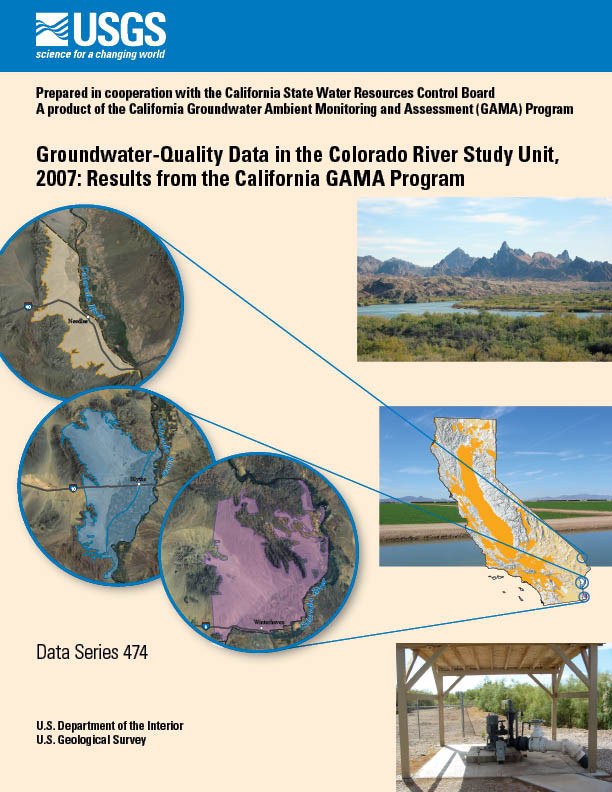Data Series 474
ABSTRACT
Groundwater quality in the 188-square-mile Colorado River Study unit (COLOR) was investigated October through December 2007 as part of the Priority Basin Project of the California State Water Resources Control Board (SWRCB) Groundwater Ambient Monitoring and Assessment (GAMA) Program. The GAMA Priority Basin Project was developed in response to the Groundwater Quality Monitoring Act of 2001, and the U.S. Geological Survey (USGS) is the technical project lead. The Colorado River study was designed to provide a spatially unbiased assessment of the quality of raw groundwater used for public water supplies within COLOR, and to facilitate statistically consistent comparisons of groundwater quality throughout California. Samples were collected from 28 wells in three study areas in San Bernardino, Riverside, and Imperial Counties. Twenty wells were selected using a spatially distributed, randomized grid-based method to provide statistical representation of the Study unit; these wells are termed ‘grid wells’. Eight additional wells were selected to evaluate specific water-quality issues in the study area; these wells are termed ‘understanding wells.’ The groundwater samples were analyzed for organic constituents (volatile organic compounds [VOC], gasoline oxygenates and degradates, pesticides and pesticide degradates, pharmaceutical compounds), constituents of special interest (perchlorate, 1,4-dioxane, and 1,2,3-trichlorpropane [1,2,3-TCP]), naturally occurring inorganic constituents (nutrients, major and minor ions, and trace elements), and radioactive constituents. Concentrations of naturally occurring isotopes (tritium, carbon-14, and stable isotopes of hydrogen and oxygen in water), and dissolved noble gases also were measured to help identify the sources and ages of the sampled groundwater. In total, approximately 220 constituents and water-quality indicators were investigated. Quality-control samples (blanks, replicates, and matrix spikes) were collected at approximately 30 percent of the wells, and the results were used to evaluate the quality of the data obtained from the groundwater samples. Field blanks rarely contained detectable concentrations of any constituent, suggesting that contamination was not a significant source of bias in the data. Differences between replicate samples were within acceptable ranges and matrix-spike recoveries were within acceptable ranges for most compounds. This study did not attempt to evaluate the quality of water delivered to consumers; after withdrawal from the ground, raw groundwater typically is treated, disinfected, or blended with other waters to maintain acceptable water quality. Regulatory thresholds apply to water that is served to the consumer, not to raw groundwater. However, to provide some context for the results, concentrations of constituents measured in the raw groundwater were compared to regulatory and nonregulatory health-based thresholds established by the U.S. Environmental Protection Agency (USEPA) and the California Department of Public Health (CDPH) and to thresholds established for aesthetic concerns by CDPH. Comparisons between data collected for this study and drinking-water thresholds are for illustrative purposes only and do not indicate compliance or noncompliance with those thresholds. The concentrations of most constituents detected in groundwater samples were below drinking-water thresholds. Volatile organic compounds (VOC) were detected in approximately 35 percent of grid well samples; all concentrations were below health-based thresholds. Pesticides and pesticide degradates were detected in about 20 percent of all samples; detections were below health-based thresholds. No concentrations of constituents of special interest or nutrients were detected above health-based thresholds. Most of the major and minor ion constituents sampled do not have health-based thresholds; the exception is chloride. Concentrations of chloride, sulfate, and total dissolved solids detected in some of the well samples were above the nonenforceable thresholds for aesthetic concerns. Concentrations of fluoride were detected in 5 samples (from 4 grid wells and 1 understanding well) above the maximum contaminant level for California (MCL-CA). Concentrations of most of the trace elements in samples from the COLOR study were below health-based thresholds; exceptions included arsenic above the MCL-US, boron above the notification level for California (NL-CA), iron and manganese above the secondary maximum contaminant level for California (SMCL-CA), and molybdenum and strontium above the lifetime health advisory level (HAL-US) threshold. Most detections of radioactive constituents were below health-based thresholds; exceptions were alpha, uranium, and radon radioactivity. Alpha radioactivity with 72 hour count detections occurred in four grid wells and one understanding well, and 30-day count detections in two grid wells above the MCL-US. Uranium was detected twice in grid wells above the MCL-US threshold. Also, radon-222 was detected at concentrations above the proposed MCL-US in 19 samples (14 grid and 5 understanding wells). No radon-222 was detected above the proposed MCL-US upper threshold. |
First posted February 10, 2010 For additional information contact: Part or all of this report is presented in Portable Document Format (PDF); the latest version of Adobe Reader or similar software is required to view it. Download the latest version of Adobe Reader, free of charge. |
Goldrath, D.A., Wright, M.T., and Belitz, Kenneth, 2009, Groundwater-quality data in the Colorado River study unit, 2007: Results from the California GAMA program: U.S. Geological Survey Data Series 474, 66 p.
Abstract
Introduction
Methods
Water-Quality Results
Summary
Acnowledgments
References Cited
Appendix